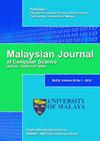REAL-TIME EYE TRACKING USING HEAT MAPS
IF 1.2
4区 计算机科学
Q4 COMPUTER SCIENCE, ARTIFICIAL INTELLIGENCE
引用次数: 0
Abstract
Communication in modern days has developed a lot, including wireless networks, Artificial Intelligence (AI) interaction, and human-computer interfaces. People with paralysis and immobile disorders face daily difficulties communicating with others and gadgets. Eye tracking has proven to promote accessible and accurate interaction compared to other complex automatic interactions. The project aims to develop an electronic eye blinker that integrates with the experimental setup to determine clinical pupil redundancy. The proposed solution comes up with an eye-tracking tool within an inbuilt laptop webcam that tracks the eye’s pupil in the given screen dimensions and generates heat maps on the tracked locations. These heat maps can denote a letter (in case of eye writing), an indication to click on that location (in case of gadget communication), or for blinking analysis. The proposed method achieves a perfect F-measure score of 0.998 to 1.000, which is comparatively more accurate and efficient than the existing technologies. The solution also provides an effective method to determine the eye's refractive error, which can replace the complex refractometers. Further, the spatially tracked coordinates obtained during the experiment can be used to analyze the patient’s blinking pattern, which, in turn, can detect retinal disorders and their progress during medication. One of the applications of the project is to integrate the derived model with a Brain-computer interface system to allow fast communications for the disabled.使用热图的实时眼动追踪
现代通信已经发展了很多,包括无线网络、人工智能(AI)交互和人机界面。瘫痪和行动不便的人每天都面临着与他人和小工具沟通的困难。与其他复杂的自动交互相比,眼动追踪已被证明可以促进可访问和准确的交互。该项目旨在开发一种电子眨眼器,与实验装置相结合,以确定临床瞳孔冗余。提出的解决方案是在内置的笔记本电脑网络摄像头中安装一个眼球追踪工具,该工具可以在给定的屏幕尺寸上追踪眼睛的瞳孔,并在被追踪的位置生成热图。这些热图可以表示一个字母(在眼睛书写的情况下),一个点击该位置的指示(在小工具通信的情况下),或者用于眨眼分析。该方法的F-measure得分在0.998 ~ 1.000之间,相对于现有技术而言,具有更高的准确性和效率。该方案还提供了一种有效的人眼屈光不正测定方法,可替代复杂的屈光计。此外,在实验过程中获得的空间跟踪坐标可以用来分析患者的眨眼模式,进而可以检测视网膜疾病及其在药物治疗期间的进展。该项目的应用之一是将衍生模型与脑机接口系统集成,为残疾人提供快速通信。
本文章由计算机程序翻译,如有差异,请以英文原文为准。
求助全文
约1分钟内获得全文
求助全文
来源期刊

Malaysian Journal of Computer Science
COMPUTER SCIENCE, ARTIFICIAL INTELLIGENCE-COMPUTER SCIENCE, THEORY & METHODS
CiteScore
2.20
自引率
33.30%
发文量
35
审稿时长
7.5 months
期刊介绍:
The Malaysian Journal of Computer Science (ISSN 0127-9084) is published four times a year in January, April, July and October by the Faculty of Computer Science and Information Technology, University of Malaya, since 1985. Over the years, the journal has gained popularity and the number of paper submissions has increased steadily. The rigorous reviews from the referees have helped in ensuring that the high standard of the journal is maintained. The objectives are to promote exchange of information and knowledge in research work, new inventions/developments of Computer Science and on the use of Information Technology towards the structuring of an information-rich society and to assist the academic staff from local and foreign universities, business and industrial sectors, government departments and academic institutions on publishing research results and studies in Computer Science and Information Technology through a scholarly publication. The journal is being indexed and abstracted by Clarivate Analytics'' Web of Science and Elsevier''s Scopus
 求助内容:
求助内容: 应助结果提醒方式:
应助结果提醒方式:


